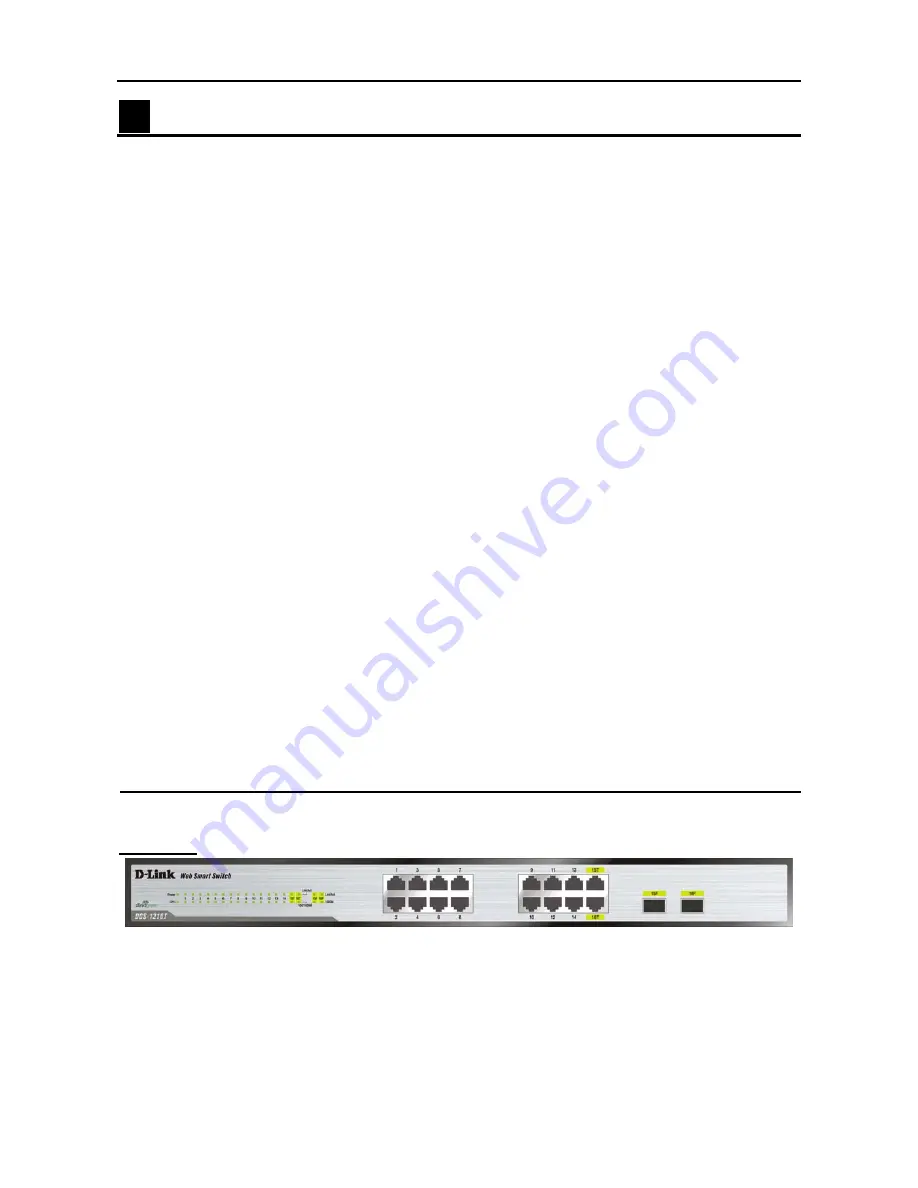
3 Product Introduction
D-Link Web Smart Switch User Manual
3
Product Introduction
Thank you and congratulations on your purchase of D-Link Web Smart Switch Products.
D-Link's next generation Web Smart Gigabit switch series blends plug-and-play simplicity with exceptional
performance and reliability for small and medium-sized business (SMB) networking. All models are housed in
a new style rack-mount metal case with easy-to-view front panel diagnostic LEDs, and provide advance
features including up to two or four combo SFP fiber connections, network security, traffic segmentation,
QoS and versatile management. Some of the advanced features include:
A Switch for Each Business Size:
With three models (16, 24 and 48) Gigabit ports to choose from, this
series provides flexible choices for different network size requirements. Since Gigabit copper ports capable
of connecting to your existing Cat.5 twisted-pair cable, these switches eliminate the need of a complex
reconfiguration process. In addition supports auto-detection of MDI/MDIX, bringing inexpensive and easy
Gigabit connection to the desktops. Each switch provides two or four combo SFP slots for flexible connection
to a fiber backbone or servers. All the SFP slots support 100M and 1000M dual speed fiber connections.
Extensive Layer 2 Features:
Implemented as complete L2 devices, these switches include functions such
as Jumbo frame support, IGMP snooping, port mirroring, Spanning Tree, port trunks. The IEEE 802.3x flow
control function allows your servers to directly connect to the switch for fast, reliable data transfer.
Traffic Segmentation and QoS:
The switches support 802.1Q VLAN standard tagging by prioritizing traffic
to enhance network security and performance. Also support 802.1p priority queues, enabling users to run
bandwidth-sensitive applications such as streaming multimedia and VoIP in network. These functions allow
switches to work seamlessly with VLAN and 802.1p traffic in network. Asymmetric VLAN is implemented in
these switches for a more efficient use of shared resources such as server or gateway devices.
Network Security:
D-Link’s innovative Safeguard Engine function protects the switches against traffic
flooding caused by virus attacks. Additional features like MAC address filters screen access to the network.
They support 802.1X port-based authentication, allowing network to be configured with external RADIUS
servers.
Versatile Management:
The new generation of Gigabit web smart switches provides growing businesses
simple and easy management of their network using an intuitive SmartConsole utility or a Web-Based
management interface that allows administrators to remotely control their network down to the port level. The
SmartConsole easily allows customers to discover multiple D-Link web smart switches with the same L2
network segment connected to user’s local PC. With this utility, users do not need to change the IP address
of PC and also provides easy initial setting of smart switches. The switches with the same L2 network
segment connected to user’s local PC are displayed on the screen for instant access. It allows extensive
switch configuration setting, and basic configuration of discovered devices such as password change,
firmware upgrade.
In addition, users can also use the built-in MIB browser to poll the switches for information about their status
and send traps of abnormal events. MIB support allows users to integrate the switches with third-party
devices for management in an SNMP environment.
DGS-1216T
16 Port 10/100/1000BaseT with 2 Combo SFP Smart Switch
Front Panel
Figure 8 – DGS-1216T Front Panel
Power LED:
The Power LED flashes when the Switch is connected to a power source.
CPU LED:
When the CPU LED is blinking, then the switch is in the normal condition. If the CPU LED is off or
stays in solid light state that means the system might have crashed or firmware upgrade has failed.
Port Link/Act LED (1-14, 15T/F, 16T/F):
The Link/Act LED flashes which indicates a network link through
the corresponding port. Blinking state indicates that the Switch is either sending or receiving data to the port.
7












































